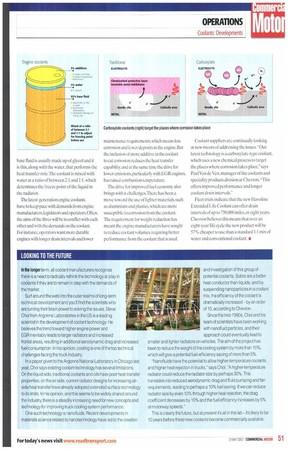LOOKING TO THE FUTURE In the longer term, all coolant
Page 51

If you've noticed an error in this article please click here to report it so we can fix it.
manufacturers recognise there is a need to radically rethink the technology at play in coolants if they are to remain in step with the demands of the market
Surf around the web into the outer realms of long-term technical development and you'll find the scientists who are turning their bran power to solving the issues. Steve Choi from Argonne Laboratories in the US is a leading scientist in the development of coolant technology. He believes the trend toward higher engine power and EGR inevitably leads to larger radiators and increased frontal areas, resulting in additional aerodynamic drag and increased fuel consumption. In his opinion, cooling is one of the top technical challenges facing the truck industry.
In a paper given to the Argonne National Laboratory in Chicago last year, Choi says existing coolant technology has several limitations. On the liquid side, traditional coolants and oils have poor heat-transfer properties; on the air side, current radiator designs for increasing airside heat transfer have already adopted extended surface technology to its limits. In his opinion, and this seems lobe widely shared around the industry, there is a steadily increasing need for new concepts and technology for improving truck cooling system performance.
One such technology is nanofluids. Recent developments in materials science related to nanotechnology have led to the creation and investigation of this group of potential coolants. Solids are a better heat conductor than liquids, and by suspending nanoparticles in a coolant mix, the efficiency of the coolant is dramatically increased by an order of 10, according to Chevron.
Since the mid-1990s, Choi and his team of scientists have been working with nanofluid particles, and their approach could eventually lead to smaller and lighter radiators on vehicles. The aim of the project has been to reduce the weight of the cooling system by more than 10%, which will give a potential fuel-efficiency saving of more than 5%.
"Nanofluids have the potential to allow higher-temperature coolants and higher heat rejection in trucks," says Choi. 'A higher-temperature radiator could reduce the radiator size by perhaps 30%. This translates into reduced aerodynamic drag and fluid pumping and fan requirements, leading to perhaps a 10% fuel saving. If we can reduce radiator size by even 10% through higher heat rejection, the drag coefficient decreases by 10% and the fuel efficiency increases by 5% at motorway speeds."
This is clearly the future, but at present it's all in the lab — it's likely to be 10 years before these new coolants become commercially available.


























































































































































































